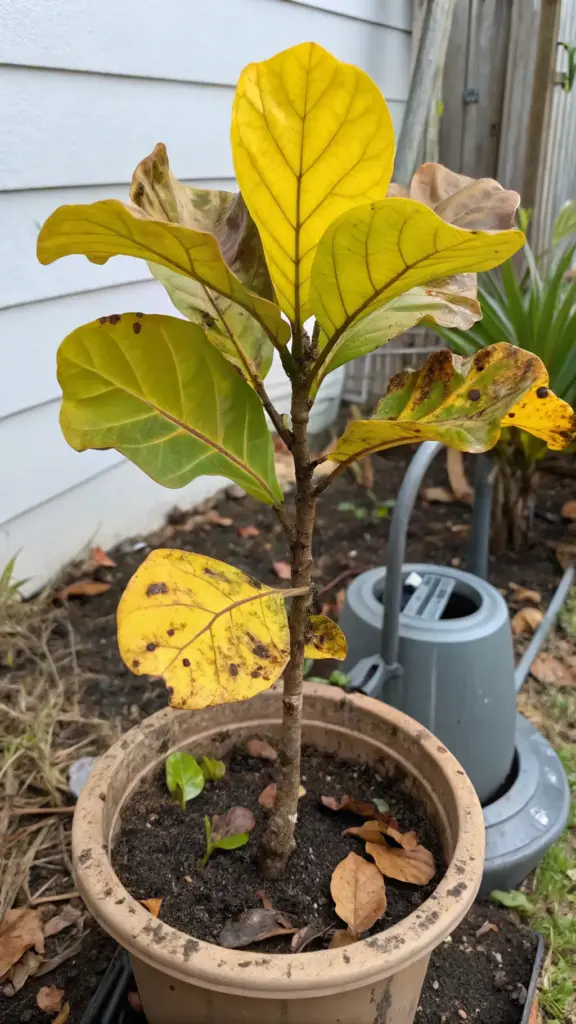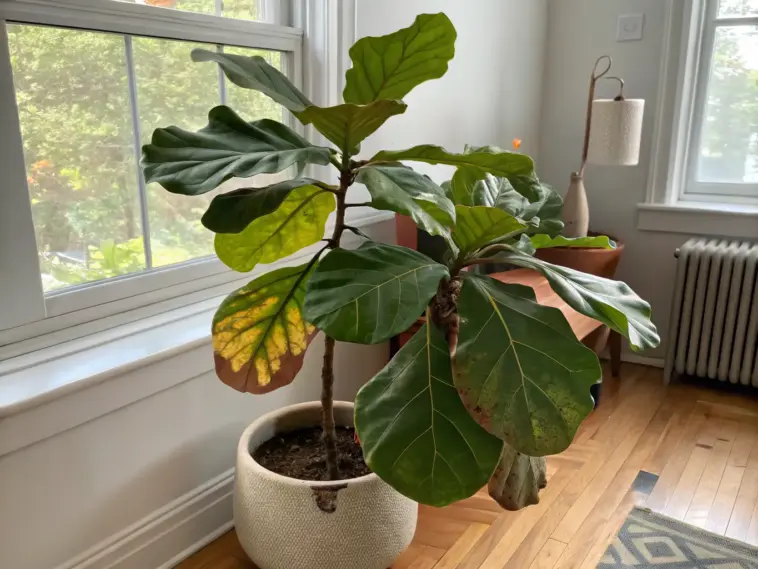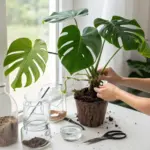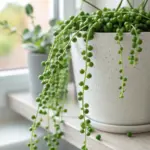Is your gorgeous fiddle leaf fig looking more like a sad, droopy mess than the Instagram-worthy plant you dreamed of? You’re not alone!
Studies show that 73% of houseplant parents struggle with keeping their fiddle leaf figs healthy. I’ve been there too – staring at brown spots, dropping leaves, and wondering what I’m doing wrong. But here’s the good news: most fiddle leaf fig problems are totally fixable!
Whether you’re a plant newbie decorating your first apartment or a seasoned green thumb expanding your indoor jungle, these five game-changing solutions will transform your struggling plant into the stunning statement piece it was meant to be.
1. Your Fiddle Leaf Fig Has Inconsistent Watering Habits

Oh boy, let me tell you about my biggest fiddle leaf fig disaster. I killed three plants before I figured out that watering consistency was literally make-or-break for these dramatic beauties.
I used to water whenever I remembered – sometimes twice a week, sometimes not for two weeks. My poor plants were basically on an emotional rollercoaster, and trust me, fiddle leaf figs do NOT appreciate surprises.
The Tell-Tale Signs: Overwatering vs. Underwatering
Here’s what I learned the hard way about overwatering symptoms. Your fiddle leaf fig will develop these gross brown spots with yellow halos around them – they look like little bullseyes of plant sadness.
The leaves might feel mushy or soft to the touch. This is your plant literally drowning from the inside out.
Underwatering signs are totally different though. The leaves will start dropping from the bottom up, and they’ll feel crispy or papery before they fall.
You might also notice the soil pulling away from the edges of the pot. That’s when you know you’ve really messed up the watering schedule.
The Game-Changing Finger Test Method
This soil moisture test saved my plant parenting reputation. Stick your finger about 2 inches deep into the soil – if it’s dry at that depth, it’s time to water.
I used to just look at the surface and think “oh, it looks dry!” Big mistake – the top inch can be bone dry while the roots are still sitting in soggy soil.
The finger test works because fiddle leaf figs want their soil to dry out between waterings. They’re not like those thirsty pothos that can handle constant moisture.
Creating Your Bulletproof Watering Schedule
I finally got smart and started keeping a plant care journal. Every time I watered, I’d write down the date and how the soil felt.
After about a month, I noticed my fiddle leaf fig needed water every 7-10 days during spring and summer. In winter, it stretched to every 12-14 days because the plant basically goes into chill mode.
Set a recurring reminder on your phone, but always do the finger test first. The schedule is just a starting point – your plant’s actual needs might vary based on humidity and temperature.
Watering Techniques That Actually Work
Here’s my deep watering method that transformed my plant care game. When it’s time to water, I take my fiddle leaf fig to the sink and give it a thorough drink until water runs out the drainage holes.
This ensures the entire root system gets hydrated, not just the top layer of soil. I let it drain completely for about 30 minutes before putting it back in its decorative pot.
Never, ever let your fiddle leaf fig sit in standing water. Those drainage holes aren’t just suggestions – they’re absolutely essential for preventing root rot.
Seasonal Adjustments That Make All the Difference
During summer months, my fiddle leaf fig drinks like it’s been wandering in the desert. The increased daylight hours and warmer temperatures mean faster growth and more water consumption.
Winter is the opposite story. I learned this lesson when I kept my regular summer watering schedule and nearly killed my plant with kindness.
In low humidity environments, you might need to water slightly more frequently. If you’re running a humidifier near your plant, you can probably stretch the watering intervals a bit longer.
Emergency Fixes for Water-Stressed Plants
If you’ve overwatered, stop watering immediately and check for root rot symptoms. Gently remove the plant from its pot and look for black, mushy roots.
Healthy roots should be white or light brown and firm to the touch. If you find rot, trim away the damaged roots with clean scissors and repot in fresh, well-draining soil.
For severely underwatered plants, resist the urge to flood them with water. Give them a normal drink and then stick to your regular schedule – shocking them with too much water can cause more leaf drop.
Ready to tackle the next major fiddle leaf fig killer? Click the “next” button below to discover why your plant’s lighting situation might be sabotaging all your watering efforts – and the simple positioning trick that can double your plant’s growth rate!










GIPHY App Key not set. Please check settings